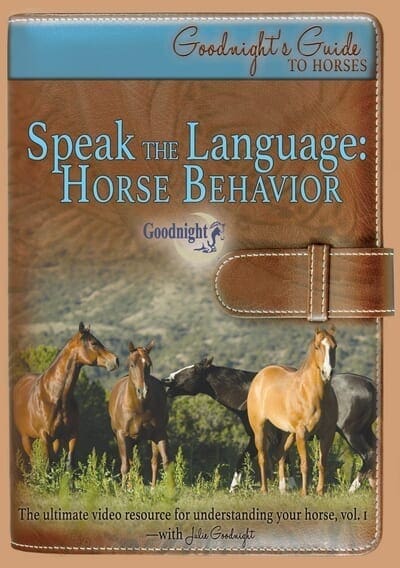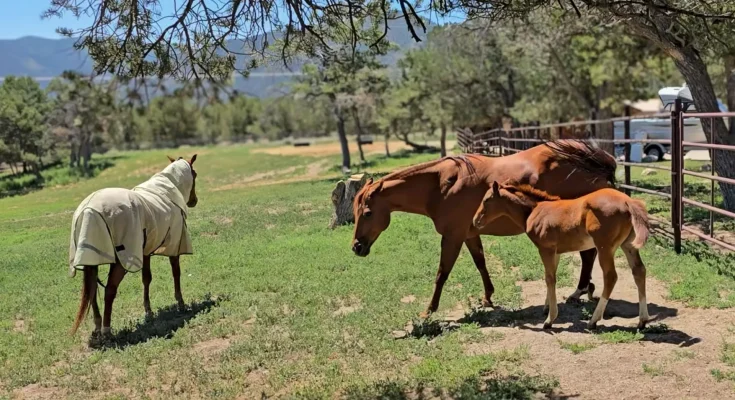Horses are emotional animals. Like humans, horses feel and display the six basic emotions.
Fear, anger and surprise are overtly expressed, and easily recognized. Displays of sadness, enjoyment and disgust can also be easy to see, but only if you know what to look for. (Just ask a horse accustomed to eating rich alfalfa—the equine equivalent of cotton candy—to eat some bland grass hay instead. You will see clear signs of disgust!)
Horses may also display more complicated emotional behaviors like jealousy and possessiveness. These may be subtle or overt displays of posturing, gesturing, vocalizing, and aggression. They can be harder to understand, and easily confused with similar emotional behaviors.
It’s important to recognize the emotions and behaviors of the horses you encounter, do your best to understand their motivations, and learn how to safely manage this type of emotionality in your horse.
Green-Eyed Monsters
Expressions of jealousy and possessiveness in horses can be a range of behaviors, from subtle gestures and positioning to full-blown aggression.
Getting stuck in the middle of jealous horses might be frightening and dangerous. I can tell you from firsthand experience, getting caught in the crossfire of jealous and angry horses can become deadly in a heartbeat.
Let’s break down these more complicated emotions, and think about how we routinely see this play out with horses.
Envy: This one is simple. It means, I want what you have. Horses constantly monitor other horses, and if they see something of interest or something they want, they may turn green with envy. Most friendly, well-mannered horses will not overstep their bounds or go into a full-blown rage over simple envy. Dominant horses tend to take what they want, when they want it, and horses with lower status generally accept that.
My herd occasionally gets watermelon rinds as a random treat (a summertime delicacy!). If you walk up to one horse with a bag full of the juicy sweet treats, soon you will be surrounded by the whole herd, vying and jostling for their share. There might be some pushing and shoving, nipping and bickering, but once the rinds are gone, it’s back to business as usual. No hard feelings, no one gets hurt.

Learn the unique characteristics of a horse’s natural behavior so you are safer, more effective and can better relate to the needs of your horse.
Possessiveness: This is a desire to control and a fear of losing a prized individual relationship. Possessive horses treat other individuals as if they are owned, and it may be more likely to involve aggression.
This is very simple in the case of a mare and her foal. My mare Annie is very possessive with her foal—inserting herself like a bowling ball between him and other horses, herding him and taking him somewhere else. That colt is hers, and hers alone. Even though the other horses take great interest in the colt, her possessiveness is clear, and she would fight to her death to maintain it.
Sometimes other horses in the herd—mare or gelding—will try to “steal” a foal, or a young horse, or a prized mare from another horse. The horse will try to separate the prize, herd it away, and may become violent to the other horses in order to keep the prize.
Resource Guarding: This is instinctive behavior that is easily triggered in horses. It occurs when horses act aggressively to communicate that they want a resource for themselves, especially when it’s in limited supply. Resource guarding is an instinct to protect something they believe is necessary for their survival or well-being.
It’s sometimes called food aggression in dogs, but with horses, valued resources are much broader than that, and it may involve food, water, shelter, other horses, or territory. For example, a mare might defend her foal from injury or bullying, or a stalled horse might display aggressive gestures to anyone coming close to his stall.
Other horses are frequently seen as a valued resource, and food (as well as its delivery system) can clearly be valued resources. So how big a leap is it to think that a human might be seen as a valued resource to a horse?
Are Horses Jealous Or Possessive Of Humans?
Yes, it’s possible, but it’s certainly not the norm. In certain scenarios, horses may form a strong relationship with a human, or think of the human as a valued resource, and become jealous of other horses or people coming close. In the case of a horse that’s routinely given high-value food rewards by the owner, possessive behavior is most likely related to resource guarding.
If treats or food are not involved, then possessive behavior may be an indication that the horse thinks of the human as something to own, like a stallion possesses a mare. Since food is not involved, we can assume this possessiveness stems from the horse’s feelings of security, comfort, desire, or pleasure, which have become associated with the human. Besides posturing, gesturing, herding, and aggression towards others, you may see additional signs of arousal or excitement at times in a horse that has become possessive over a person.
Jealous and possessive behavior stem from the individual’s temperament. Not all horses behave in this way, but it is certainly not uncommon. Status in the herd, life experience, confidence level, living arrangements, how they are fed, how they are managed, and how they are handled, all have a bearing on the horse’s behavior.
Signs of possessiveness to watch for include excessive nickering (the horse’s way of beckoning you), or horses that are over-attentive, excited, or aroused for reasons that don’t make immediate sense. These are signs that a horse may be jealous or worse. Pinning ears, snaking the neck, baring teeth, showing whites of the eyes, herding, blocking/positioning, squealing, and kicking with double barrels are common in horses that are protecting or guarding something.



